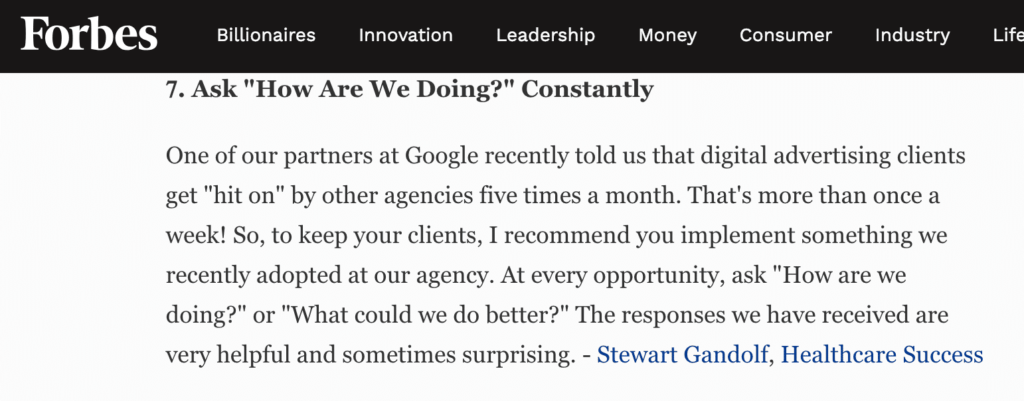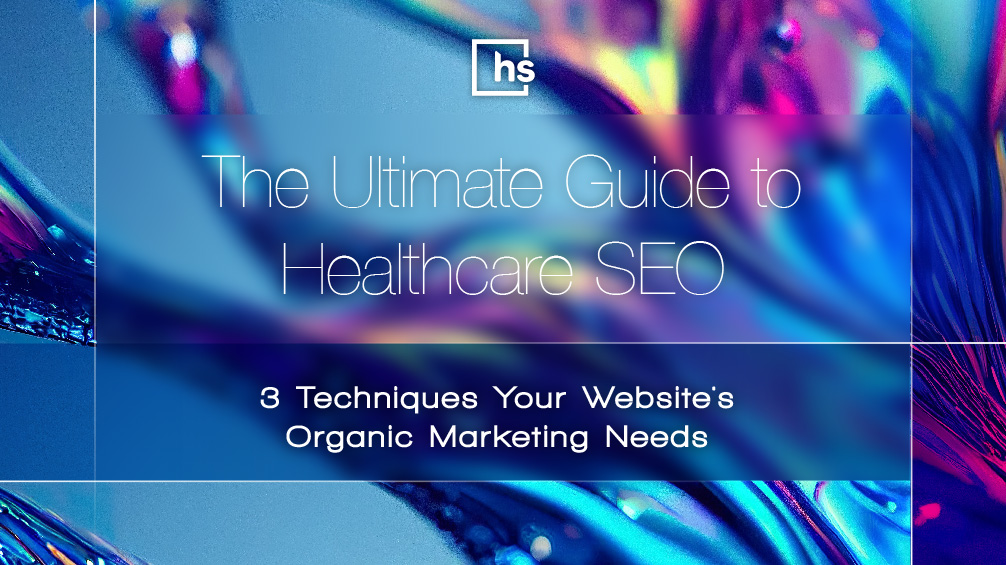The Ultimate Guide to Healthcare SEO: 3 Techniques Your Website's Organic Marketing Needs
A successful health system, hospital, practice, or healthcare organization website facilitates patient communication and helps you win more patients you want.
But this doesn’t mean much if patients can’t find your website. To get on page #1 for an organic search, you need a strong healthcare marketing SEO company, a solid website, an even stronger medical SEO strategy, and a tactical SEO team.
| SEO stands for search engine optimization and refers to the art and science of optimizing a website or landing page to increase its visibility on search engines like Google, Bing, or Yahoo. SEO aims to drive more organic (unpaid) traffic to your website (or landing page) by improving the quality and relevance of your content in a way that is beneficial for your target audience and easy for search engines to understand. In addition to improving website content, SEO is achieved by optimizing several on-page and off-page elements like header tags, meta descriptions, image tags, URLs, high-quality backlinks, and social engagement. |
A strong healthcare SEO strategy requires time, money, or both to find your website on the first page of search engine results.
SEO services for healthcare organizations require relentless focus and comprehensive efforts from your specialized healthcare SEO agency.
Organic SEO for the Healthcare Industry: Changing Rules and Algorithms
By employing the proper techniques and avoiding black hat organic marketing, you can achieve higher search engine rankings for your healthcare business. Black hat SEO techniques involve tricking users and search engines to get pages to the top of Google and other major search engines.
The problem with this is Google’s algorithms are continuously changing. They’ve taken measures to thwart these black hat SEO methods and penalize healthcare websites attempting to use them.
If you’re ever approached by an SEO “organic marketing professional” making promises for “quick results” that sound too good to be true, they probably are too good to be true.
The best healthcare SEO is a long-term strategy involving three core SEO-specific techniques.
1. On-Site Healthcare SEO Techniques
On-site or on-page technical healthcare SEO refers to the code, images, and words that make up your website. This includes the type of content you have on your health services website, how fast it loads (e.g., page load speed), and its mobile responsiveness. There are a variety of healthcare SEO services that impact your site performance.
Site Architecture
The key to getting a higher organic page rank for more of your desired keywords and phrases lies in proper internal linking and good site architecture using something called “siloing.”
Siloing is an SEO technique where you group, isolate and interlink content about a specific topic. This creates silos (e.g., sections) of related content, which helps guide users and search engines throughout your website clearly and clearly.
Siloing also helps search engines crawl, index, and rank your website better.
Keyword Research
The healthcare market is highly competitive. Understanding what words and phrases your target audience is searching for (as well as their search intent) is a crucial first step toward winning a high organic page rank for your website.
Once you know which words and phrases your audience commonly uses, you can create an effective content marketing strategy and produce content based on your findings.
Produce Content Based on Keywords
When it comes to SEO, content remains king. Now that you’ve researched the relevant keywords and phrases your target audience favors, you can create a siloed content strategy based on that data. This helps users and search engines better understand your content's structure and where to find it.
Optimize Title Tags
These are HTML (coding) elements within your site's backend that specify the titles of your web pages. The titles are displayed on SERPs (search engine results pages) as the clickable headlines for a given search result.
Page titles must accurately describe your page and include relevant keywords and phrases to help Google understand your content and rank your page.
Optimize Description Tags
Meta descriptions appear beneath the title tags in SERPs and summarize the web page’s content. These description tags are an essential piece of the SEO puzzle because search engines use them to determine whether the content is on topic and relevant to the user's search intent.
Here are a few key factors to keep in mind when writing meta descriptions:
- Describe the page using primary and secondary keywords or phrases.
- Place the primary keyword as close to the beginning of the sentence as possible.
- Keep all meta descriptions between 155-160 characters (including spaces).
- Add a call to action (CTA) like “Learn more” or “Schedule an appointment.”
Optimize Keyword Meta Tags
Like the title and meta description tags, keyword tags are found in a webpage’s HTML source code and aren’t visible to online visitors but to search engines. Your keywords determine what you want to be found for in SERPs.
Meta keywords give search engines additional information about your site’s content, allowing them to show the website in the appropriate search results.
Site Speed
Site speed, also called page speed, measures how fast your web pages load. This information helps Google determine where your page will appear in SERPs.
Google’s recommended page load speed is under two seconds—and they reward fast-loading sites over slower ones.
Mobile Responsiveness
Your medical website SEO content should be extremely mobile-friendly. With more customers going mobile and searching for hospitals and practices “near me,” this is a vital part of your SEO strategy.

Optimize Anchor Text Links
Anchor text is the clickable text within a hyperlink in your content. It should be contextual and part of the body copy (e.g., it should not say “click here” or “learn more”). Instead, it should give the user an idea of what to expect should they click.
SEO best practices indicate that your anchor text should be relevant to the page you’re linking to and include a keyword or phrase.
Here are two types of links:
Outbound links
Hyperlinked text within a web page that links to an external site is called an outbound link.
Here are a few guidelines to follow:
- Link to cite the source of your claim, statistic, or fact
- Link only to credible websites
- Avoid linking to competitor websites
Internal links
Hyperlinked text within a web page that links to an internal page is called an internal link. When done strategically, internal links improve website navigation, increase page authority, and help search engines discover helpful content and understand the structure of your website.
An internal linking strategy also supports your SEO keyword strategy as it helps search engines easily identify the keywords, topics, and related content that are the primary focus of your website.
Alt Tags
Alt tags are HTML attributes found in your site's source code and applied to image tags. They describe the image in words, providing a text alternative that search engines can use to index it correctly.
Failing to include alt tags can negatively impact your search engine rank.
H1 and H2 Tags
H1 and H2 are HTML attributes found in your site's source code. These header tags help search engine algorithms better understand how your web page is structured.
But they’re also headings for your readers. Like the title of an article and subheadings throughout the post, header tags break up content blocks, creating scannable text that lets readers quickly locate the information they need most.
Here are a few best practices:
- Always include an H1 tag; this is the title of your page
- Use only one H1 tag per web page to create a proper content hierarchy
- Always include a primary keyword in your H1
- Ensure your H1 is no longer than 70 characters (including spaces)
- Use H2s on every page and try to include a keyword
- Use H3s and H4s when your text is long and you need further content blocks
- Maintain a consistent user experience (e.g., if you choose title case for H1s and H2s, be sure to keep it consistent throughout the site)
- Ensure all headings satisfy search intent and engage the reader
Bold, Italics
Google bots like bold and italic formatting because they emphasize the most important and relevant text.
Likewise, bold and italic text help improve a web page's readability, making it easier for readers to scan and understand the page's central message.
However, using too much bold or italic formatting on a webpage can negatively impact the user experience and SEO in several ways, including
- Poor readability
- Poor accessibility for users with visual impairments or cognitive disabilities
- Diminished emphasis on relevant content
Overusing bold and italic formatting may also result in your website being penalized or banned by search engines because it seems like you are keyword stuffing (a black hat SEO tactic used to manipulate search results).
Footer
How you optimize the footer menu of your website further identifies your site’s relevance on SERPs.
For example, strategically placed internal links will improve your user experience and support your internal linking strategy, while external links may harm your SEO.
XML Sitemaps
XML stands for extensible markup language and is similar in context to HTML.
An XML sitemap is a file that lists a website’s essential pages and invites search engines to crawl the URLs. It is highly recommended for large sites with frequently changing URLs.
In addition to having an XML sitemap in your site's source code, a visible sitemap—one that your visitors can see—is vital for strong SEO practices.
Changing Content
Google has stricter guidelines for the healthcare industry. Your healthcare and medical content should be regularly audited and updated to reflect the latest information.
Refreshing outdated content ensures your website is accurate, up-to-date, and relevant. It also helps increase the effectiveness of your healthcare SEO efforts, boost search engine traffic, increase site visits, and improve conversions.
2. Off-Site Healthcare SEO Techniques
Google considers websites linked to other relevant healthcare-related websites “more important” than sites without any of these backlinks.
Healthcare businesses want highly relevant backlinks because they give their web pages authority and credibility when ranking well on the SERPs.
Aim for backlinks that point to your website from the following “off-site” sources:
Press Releases
Press releases are a terrific way to inform journalists and major healthcare publications about your organization's major events (e.g., winning an award or launching a new product or service).
They are also a powerful link-building tool that helps build referral traffic. How? When an online news website shares your original press release, a new SEO backlink to your website is created—further extending your reach and authority.
Healthcare Directories
Local directories help existing and new patients find your healthcare business. They also play an essential role in healthcare companies' SEO. Ranking factors include where and how often businesses and practices are listed in directories and accurate and consistent information across those directories (e.g., location, hours of operation, services offered, etc.)—more on directories below.
Be imaginative and reach out to a wide range of credible directories. For example, Design Rush is an agency directory that links to our website.
Blogs and Articles
Blog content and online articles support SEO for hospitals and healthcare organizations because they help position your website as a relevant answer to your customers’ questions.

Healthcare Social Media
There is some debate as to the extent to which social media impacts hospital SEO. Most healthcare SEO experts agree that a higher number of likes and follows on social media pages, especially Facebook, increases your site's relevancy and its opportunity to appear on page #1 of Google.
Your Reputation Management
The average consumer reads seven reviews before deciding to trust a business. You should try responding to negative and positive reviews, but avoid HIPAA compliance violations. Your responses must never disclose a patient’s identity.
3. Local SEO for Healthcare Off-Site Techniques
Local SEO, or local search, optimizes your site to generate traffic from location-based searching. When you work with our Healthcare Local SEO experts, you’ll be introduced to the concept of the Google Local Pack, also called a carousel.
This grouping of similar businesses appears near the top of the page in a Google search. For example, if a site visitor searched for “Women’s Health in Los Angeles, CA,” they’d be shown a group of businesses that match that description within a mapped area.
Citations
Citations are online references to your healthcare organization’s name, address, and phone number (NAP). Like backlinks to your website, Google and other search engines use citations when evaluating the online authority of your business.
Directories
We mentioned above the importance of maintaining accuracy and consistency within directories. What we mean by this is that dissimilar listings can confuse search engines. For instance, if we’re listed as “Healthcare Success” on multiple directories, we shouldn’t be listed as “Healthcare Success Strategies, LLC” on others.
If you’re unsure of your directory listings or consistency, many affordable online resources can help you update them.
Some popular healthcare-specific content directories include:
- MedlinePlus.gov
- SAMHSA.gov
- HealthGrades
- RateMDs
- Specialty sites like VeinDirectory.org
- NIH.gov (and NIH's MeSH)
- RealSelf
- AMA Doctor Finder (and AMA's InnovationMatch.AMA-assn.org)
- CMS Physician Compare
- Castle Connolly Top Doctors
Online Review Sites
Would you believe the most trusted consumer rating websites are Google Business Profile, Facebook, and Yelp? As part of your reputation management, you muse keep a pulse on what’s being said about your healthcare organization on these sites and respond accordingly. Other consumer rating websites include:
- BBB.org
- ZocDoc
Continue reading about SEO for healthcare companies and more in this book from Healthcare Success CEO Stewart Gandolf and Mark Tager, MD: Cash-Pay Healthcare, available now!
Related Articles:
How to Optimize Content for SEO to Rank Higher
Does SEO Really Matter for Healthcare?
How Healthcare SEO Has Changed The Past Decade and What’s Ahead
Why Local Search Marketing Strengthens Your Overall SEO Strategy (Plus, 16 Common Mistakes to Avoid)













